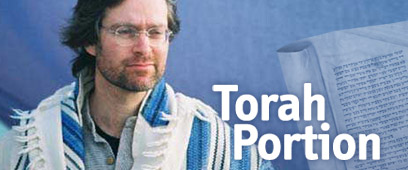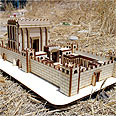

Furthermore, would it not seem that mystic philosopher Rabbi Abraham Isaac Kook was right when he said that the animal sacrifices which demarcated the ancient temple hold little attraction for spiritually evolved moderns?
And yet we do yearn for just that. The temple is a building that incarnates an idea- one of the most powerful, potent and passionate ideas in the world.
This week's parsha describes the tabernacle, the first miniature temple in the desert, a model virtually identical to the temple in Jerusalem.
Indeed, it is almost a given in kabbalistic (mystical) sources that the temple, even if also a historical dream, is primarily a symbol. But a symbol of what? Without answering this question, a large portion of Jewish ritual and consciousness is rendered unintelligible at best, and an unholy trinity of fundamentalism, spiritual chauvinism and messianic nationalism at worst.
Three texts
Three passages from the talmud and an ancient esoteric mystical tradition may guide us in our search for understanding.
The first text jolts us to the realization that our intuitive thoughts about things holy may need fundamental re-orienting.
"Rabbi Isaac said, 'the day the temple was destroyed, the taste of sex was taken away, and given to the sinners (i.e. those engaged in illicit sex)….as the verse says in Proverbs, "Stolen Waters are Sweet."
Illicit sex refers specifically to adultery; the 'taste of sex' is an idiom meant to refer to the ultimate sexual experience. According to this passage, the difference between temple and post-temple spirituality is that after the destruction, the fullest joy of sex was very difficult to access with our partners. The yearning for the temple is understood as a yearning for eros of the most intense kind.
Golden cherubs
The second text is a description of the innermost sanctum of the temple. This week's Parsha describes the two cherubs of gold atop the ark in the holy of holies. When God speaks – it is from in between the cherubs.
The talmud says the cherubs were locked in embrace when in the holy of holies, "in the love of a man and woman."
But a careful reading of the Hebrew indicates that they were in fact sexually intertwined, and according to the Bible (1 Kings), the walls of the first temple were covered with erotic pictures of these sexually involved cherubs. This is our first indication of a close association between holiness and eros.
However, to understand what eros means in the religio/cultural context of temple we need to unpack a final source.
Dialogue with God
The talmud describes a mythic dialogue between the rabbis and God during the second temple period, at the close of the era of prophecy. The Rabbis entreat God to nullify the powerful lure of idolatry.
God grants their wish, but a fiery lion immediately emerges from the holy of holies. This lion from the innermost sanctum of the temple is identified by the prophet as the primal urge toward idolatry. The rabbis realize they cannot slay the lion, so they weaken it instead.
Then the rabbis, apparently feeling that it was a moment of divine grace, turn once again to God. "Allow us to slay the drive for sexuality," they say.
Again God grants their wish, and another fiery lion emerges from the holy of holies- this one is understood to be the primal sexual drive.
But when they attempt to slay this lion, the world simply stops. Chickens don't lay eggs, people don't go to work, all productivity and, according to a chassidic reading of the text, all spiritual work grinds to a halt.
The rabbis understand they have gone too far and retract their request. The sex drive is weakened, but not slain.
Eros and holiness
What is this strange and holy mythic tale trying to teach us? The underlying teaching would seem to be that the seat of eros and the seat of holiness are one. The first lion to emerge from the holy of holies personifies the drive for idolatry, the second the sexual drive.
Both, however, are but expressions of common underlying reality – that of eros. The seat of eros is none other than the holy of holies!
Idolatry at its core is not primitive fetishism. It is rather a burning lust for the holy. Under every tree, in every brook, courses primal divinity. The idolater, like the prophet, experiences the world as an erotic manifestation of the God force.
Therefore, only the prophet is able to identify the lion as the drive for idolatry. One nineteenth century kabbalistic writer, Tzadok HaCohen from Lublin suggests that this passage is about the end of the prophetic period and that the idolater and prophet were in fact flip sides of the same coin.
The symbolism of the lions emerging from the holy of holies is the text's way of teaching that eros is holiness.
Eros: More than sex
In this understanding, eros includes sexuality as a primary manifestation, but it is clearly not limited to sex. Rather, it rather refers to the primal energy of the universe. Eros is where essence and existence meet. It is to taste essence in every moment of existence.
As this third passage indicates, the drive to uncover the divine sensuality of the world is not without danger. The erotic may overwhelm us, to the point that our ethical sensitivities are swept away and our sacred boundaries overrun. And yet the need to experience the world in all of its divine eros remains a primal human need.
The destruction of the temple meant the fall of eros, indicating that eros cannot be limited to sexuality. Sex alone cannot sate us in our lust for essence. When we mourn the destruction we yearn to live erotically in all the facets of our lives once again.
The talmud relates that at the time of the destruction, fruits lost their taste, laughter vanished, and sexual vitality, teaches Rabbi Isaac, was reserved for those seeking illicit, adulterous thrill.
The passionate yearning for rebuilding the temple is the longing to redeem eros from its distortions. We must move from the eros of longing symbolized by exile to an eros of fulfillment. We need to experience the full intensity of erotic relationship with our partners.
Put succinctly, to rebuild the temple is to touch the passion of ilicit sex within the holy and ethical context of my relationship with my wife.
It is for this that we yearn when we pray for the temple, with its golden cherubs, to be restored. We pray not for the temple building, but rather for a temple consciousness to infuse and guide our lives.
Rabbi Mordechai Gafni - Teacher and student of Torah; Leader of Bayit Chadash Spiritual Community and Movement; Chair of Integral Kabbalah at Integral Institute of Ken Wilber
The "Bayit Chadash" website: www.bayitchadash.org















